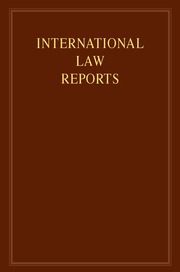No CrossRef data available.
Article contents
The Camouco (Panama v. France)
Published online by Cambridge University Press: 01 January 2021
Abstract
International tribunals — International Tribunal for the Law of the Sea — Applicable law — United Nations Convention on the Law of the Sea, 1982 — Judicial function — Relationship between Convention and the Rules of the Tribunal
Sea — Exclusive economic zone (“EEZ”) — Coastal State jurisdiction over EEZ — Arrest of vessel — Requirement of prompt release — United Nations Convention on the Law of the Sea, 1982, Articles 73 and 292 — Amount of bond for release of vessel and Master — Whether reasonable — Criteria of reasonableness
Treaties — Interpretation and application — United Nations Convention on the Sea, 1982
Keywords
- Type
- Case Report
- Information
- Copyright
- © Cambridge University Press 2004
References
1 A. O. Adede, The System for Settlement of Disputes under the United Nations Convention on the Law of the Sea, A Drafting History and a Commentary, Martinus Nijhoff Publishers, Dordrecht/Boston/Lancaster, 1987, p. 161.
2 Center for Oceans Law and Policy, University of Virginia, United Nations Convention on the Law of the Sea 1982, A Commentary, Vol. V, M. H. Nordquist, Editor-in-Chief, S. Rosenne and L. B. Sohn, Volume Editors, Martinus Nijhoff Publishers, Dordrecht/Boston/London, 1989, pp. 70–1.
3 Ibid., pp. 69–70.
4 See R. Lagoni, “The Prompt Release of Vessels and Crews before the International Tribunal for the Law of the Sea: A Preparatory Report”, The International Journal of Marine and Coastal Law, Vol. 11, No 2, 1996, p. 152.
5 Statement in Response of the French Government, 25 January 2000, paragraph 10 of the section relating to the law (English translation of the Statement in Response).
6 Lagoni, op. cit., p. 150.
7 As to how the Applicant interprets the 10-day limit, see the Application of Panama, paragraph 4 (English translation of the Application)
8 Application of Panama, paragraph 40 (English translation of the Application). See also paragraph 42 of the Judgment.


